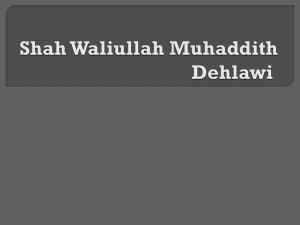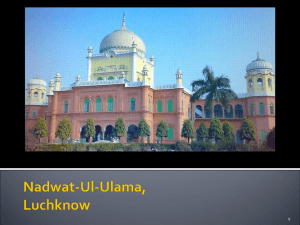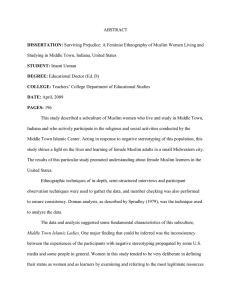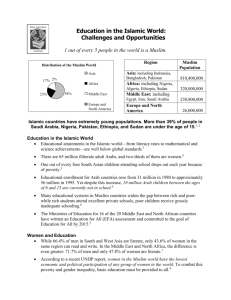An Islamic perspective on end of life issues
advertisement
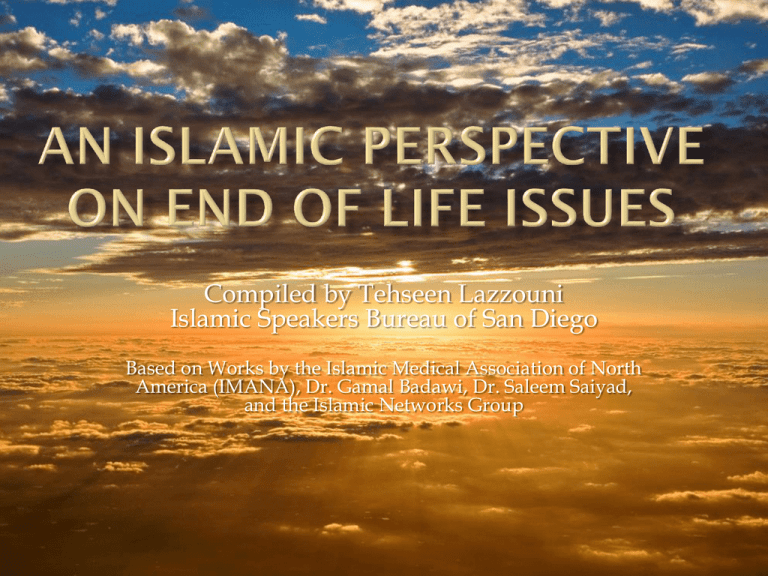
Compiled by Tehseen Lazzouni Islamic Speakers Bureau of San Diego Based on Works by the Islamic Medical Association of North America (IMANA), Dr. Gamal Badawi, Dr. Saleem Saiyad, and the Islamic Networks Group • • • • • Islam: “Peace through Submission to God” Muslim: “One who Submits to God” Monotheistic Faith following the Abrahamic tradition Worldwide Muslim Population: > 1.6 Billion U.S. Muslim Population: ~7 Million 2 • • • • • • God Angels Prophets Holy Books Day of Judgment Will of God 3 • • Based on Islamic laws—the Shari’ah—in place to benefit humans Major goals of Shari’ah—protection and preservation of: • • • • • Life Intellect Progeny Property Religion 4 • • First Principle (from the Qur’an): “Whosoever saves a human life, saves the life of the whole mankind.” Second Principle (from the Hadith): “There is no disease that God has created, except that He also has created its treatment.” 5 • • • • Necessity overrides prohibition Harm must be removed at every cost if possible Accepting the lesser of two harms if both cannot be avoided Public interest overrides individual interest 6 1. 2. 3. 4. 5. 6. Muslim patients should be identified as Muslim Respect for modesty and privacy No pork or alcohol Facilitate daily prayers if possible Inform patients of their rights; encourage living will Explanation of test procedures and treatment 7 7. 8. 9. 10. 11. Allow Imam to visit and pray for patient Autopsy permitted if necessary Organ donation permitted within guidelines Female patient exam in presence of another female After death, allow arrangements for Islamic burial 8 • • • • The human body is a trust Obligation to seek a cure Suicide and active euthanasia prohibited Patient’s right to know (unless abdicated) 9 • • When death is inevitable, as determined by a team of physicians, patient should be allowed to die without unnecessary procedures. Ongoing medical treatments can be continued. Mechanical support can be withdrawn. Patient should be treated with full respect, comfort measures, and pain control. No attempt to withhold nutrition & hydration. 10 • • • • Family should be contacted Common to have many visitors, even nonrelatives Qur’anic recitation desired Muslim patient asked to reaffirm their cardinal beliefs 11 • Two Different Views: Person considered alive; withdrawal of life support forbidden if endangers life of patient (ING View) • Should not prolong misery of dying patients; imam should be included in decision-making process (IMANA View) • 12 • Death an event under complete control of God • • “No soul can die except by Allah’s permission.” According to Shari’ah, person considered dead when either of the following two signs is noted: Heartbeat and breathing stop completely; doctors decide these cannot be restarted • All the functions of brain stop completely; doctors and specialists confirm this is irreversible and brain has started to disintegrate • 13 • • • General consensus on DNRs in Islamic community is still evolving; decision of medical futility to be determined by doctors on the case. In the absence of terminal illness or futile care situations, the Muslim patient should seek medical treatment, including resuscitation, until recovery or stage of terminal illness or vegetative state is reached. Encouraged to have a written living will and to be “full code”—agreement to use all recognized therapies, given reasonable chance of recovery. 14 • • • • • Patient’s eyes to be closed Body to be covered Family may ask for body to be turned so patient can face Mecca, if possible Body washed and wrapped in a white cloth before burial Burial to take place quickly—no cremation or embalming 15 • Two contrasting opinions on organ donation: • 1. Not allowed—we do not own our bodies • 2. Allowed and encouraged—great act of charity • IMANA takes the second opinion: organ donation allowed under the following conditions: • If specifically indicated by the deceased in a will or on • • • • driver’s license For purpose of saving life No financial incentive No cost to donor’s family No donation of reproductive organs 16

